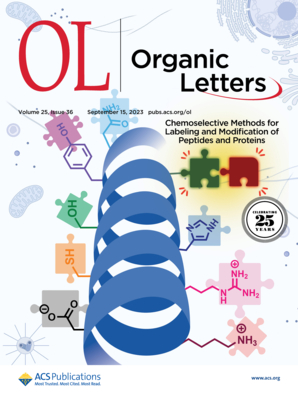基于C(sp2) -C (sp2)偶联的芳基喹啉光催化ent -使能c3 - n杂芳化反应机理研究
IF 5
1区 化学
Q1 CHEMISTRY, ORGANIC
引用次数: 0
摘要
通过脱羧自由基-自由基交叉偶联(C(sp2) -C (sp2))与肟酯,提出了ent介导的2-芳基喹啉的c3 - n -杂芳化反应。光活化后,光催化剂的三重态能量被转移到两个反应伙伴(肟酯和2-苯基喹啉)。被激发的肟酯发生脱羧裂解,形成c中心的n -杂芳基自由基和n中心的亚胺自由基。前者攻击喹诺啉二自由基的C3位点,而后者作为氢原子萃取剂(HAA)。计算研究表明,C-C键与杂芳基自由基的形成在能量上比C-N键的形成更有利。本文章由计算机程序翻译,如有差异,请以英文原文为准。

A Mechanistic Perspective on Photocatalytic EnT-Enabled C3-N-Heteroarylation of Aryl Quinoxaline via C(sp2)–C(sp2) Coupling
An EnT-mediated C3-N-heteroarylation of 2-aryl quinoxalines via decarboxylative radical–radical cross-coupling (C(sp2)–C(sp2)) with oxime esters is presented. Upon photoactivation, the triplet energy of the photocatalyst is transferred to both reacting partners (oxime ester and 2-phenylquinoxaline). The excited oxime ester undergoes decarboxylative fragmentation to a C-centered N-heteroaryl radical and an N-centered imine radical. The former attacks the C3 site of the quinoxaline diradical, while the latter acts as a hydrogen atom abstractor (HAA). Computational studies revealed that C–C bond formation with the heteroaryl radical is energetically more favorable than C–N bond formation.
求助全文
通过发布文献求助,成功后即可免费获取论文全文。
去求助
来源期刊

Organic Letters
化学-有机化学
CiteScore
9.30
自引率
11.50%
发文量
1607
审稿时长
1.5 months
期刊介绍:
Organic Letters invites original reports of fundamental research in all branches of the theory and practice of organic, physical organic, organometallic,medicinal, and bioorganic chemistry. Organic Letters provides rapid disclosure of the key elements of significant studies that are of interest to a large portion of the organic community. In selecting manuscripts for publication, the Editors place emphasis on the originality, quality and wide interest of the work. Authors should provide enough background information to place the new disclosure in context and to justify the rapid publication format. Back-to-back Letters will be considered. Full details should be reserved for an Article, which should appear in due course.
 求助内容:
求助内容: 应助结果提醒方式:
应助结果提醒方式:


